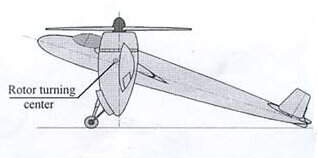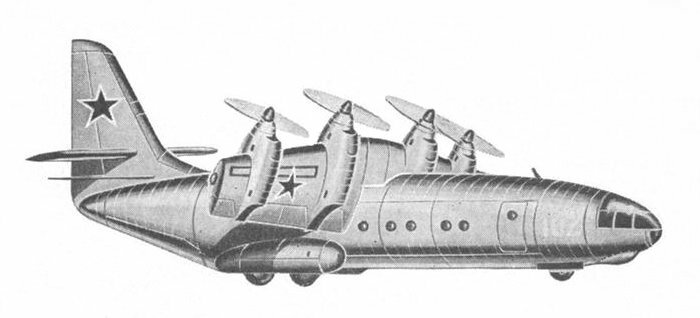You are using an out of date browser. It may not display this or other websites correctly.
You should upgrade or use an alternative browser.
You should upgrade or use an alternative browser.
Early Tiltrotors including the Baynes Heliplane
- Thread starter Justo Miranda
- Start date
-
- Tags
- great britain late 1930s
Thanks
W
Wingknut
Guest
Platt-LePage Aircraft
ACCESS: Confidential
Platt-LePage Aircraft had design studies for two Tilt-Rotor designs going back as early as 1940.
Their PL-16 Tilt-Rotor Transport:

One of their ex-engineers Bob Lichten, (Lichten worked directly with Mr. Platt) took Haviland Platt's Tilt-Rotor concept to Bell Helicopter. (Compare Platt's patent to the Bell XV-3)
Bell Helicopter would later make a settlement with Haviland Platt for the use of Platt's Tilt-Rotor patents.
Their PL-16 Tilt-Rotor Transport:

One of their ex-engineers Bob Lichten, (Lichten worked directly with Mr. Platt) took Haviland Platt's Tilt-Rotor concept to Bell Helicopter. (Compare Platt's patent to the Bell XV-3)
Bell Helicopter would later make a settlement with Haviland Platt for the use of Platt's Tilt-Rotor patents.
luedo34
The worst is yet to come!
- Joined
- 9 May 2009
- Messages
- 98
- Reaction score
- 11
Did the design for the PL-16 really beginn that early? I have always read that this projects was from 1945/6.
Very intersting aircraft would love to know more about it!
Are there any other early tiltrotor / tiltprop designs apart from the well known Baynes Heliplane, the Fa 269 and the Weserflug P 1003/1?
Very intersting aircraft would love to know more about it!
Are there any other early tiltrotor / tiltprop designs apart from the well known Baynes Heliplane, the Fa 269 and the Weserflug P 1003/1?
- Joined
- 7 June 2009
- Messages
- 532
- Reaction score
- 157
luedo34 said:Are there any other early tiltrotor / tiltprop designs apart from the well known Baynes Heliplane, the Fa 269 and the Weserflug P 1003/1?
Yes - Soviet MAI "Sokol" (Falcon) VTOL fighter project from 1936. It was sometimes discussed here:
http://www.secretprojects.co.uk/forum/index.php/topic,2072.0.html
http://www.secretprojects.co.uk/forum/index.php/topic,6106.0.html
Here is some more info about this project in Russian:
http://vtol.boom.ru/rus/Sokol/index.html
- Joined
- 7 June 2009
- Messages
- 532
- Reaction score
- 157
luedo34 said:Thanks a lot Readstar72, very interesting!
Im am very interested in this kind of aircraft. Did the USSR have any post war tilt-rotor projects ? I only know of the Mi-30 and the M-12.
Yes, we had – and not only postwar. The first was wartime, while it was only a student’s project. In 1944, 20-years-old Shota Hutsishvili, a Georgian native and a student of Tbilisi aviation college, designed it as his graduation work. He proposed a single-seat VTOL tilt-wing fighter with two radial engines and props/rotors of 5 m diameter. He called it “Gelikopter-samolet”, or “helicopter-airplane”. The project didn’t develop further, but its author became a MAI student without any exams.

In 1947, Hutsishvili proposed another “helicopter-airplane” project. It was tiltrotor with engine nacelles mounted on wingtips; the props became larger (9 m diameter) and looked more alike helicopter rotors. Its supposed takeoff weight was 2200 kg, and maximum speed about 360 km/h with 2500-hp powerplant. This project was considered by the Expert Council of MAP SSSR (USSR Ministry of aircraft production), but was rejected because of underdeveloped rotors and flight control systems.
The next was Ivan Bratukhin, known as a helicopter designer. In 1955-56, working at CAGI, he proposed a tilt-wing VTOL transport aircraft with two mighty NK-12MV turboprops. He calculated it could transport 5 ton load to 1250 km with 700 km/h cruise speed. The takeoff weight was about 30 tons.
A similar project was designed by SKB MAI in 1963, but it had four turboprops:

https://web.archive.org/web/20101230163319/http://vtol.boom.ru/rus/mai/index.html
Also, Beriev OKB worked in 1960s on the design of VTOL transport aircraft. It was Be-32 program (not to confuse with modern little turboprop airliner!) There were many different projects of Be-32 designed, just like its Myasischev competitor M-12. Most of them were jets with additional lift engines. But it was also a quad-tiltrotor version, similar to Curtiss X-19, but much larger:
https://web.archive.org/web/20101230163319/http://vtol.boom.ru/rus/Be-32652/index.html
Last edited by a moderator:
- Joined
- 7 June 2009
- Messages
- 532
- Reaction score
- 157
And also, one very interesting VTOL project was designed by Alexey Scherbakov, known for his Sche-2 (rus. Ще-2) transport airplane. The project was designated VSI - Vysokoskorostnoy Istrebitel (High-Speed Fighter), but it also would be VTOL capable. It wasn't tiltrotor - it was "tilt-jet" like VJ-101C or XF-109, but much earlier! This project was proposed in 1947!

This is tunnel model of the VSI on this photo. The real aircraft might have two RR Nene / Klimov RD-45 turbojets, and expected maximum speed was 1500 km/h! (I think it was too optimistic). The project got an approval from Professors B.N. Yuriev and V.S. Pyshnov of VVIA (Voenno-Vozdushnaya Inzhenernaya Akademiya - Air Force Engineering Academy), and also from VVS command. There were even built a special testbed and a stripped version or VSI (with Jumo engines) for tests. But later, the program was accepted too risky, and the tests were stopped.
http://vtol.boom.ru/rus/vsi/index.html

This is tunnel model of the VSI on this photo. The real aircraft might have two RR Nene / Klimov RD-45 turbojets, and expected maximum speed was 1500 km/h! (I think it was too optimistic). The project got an approval from Professors B.N. Yuriev and V.S. Pyshnov of VVIA (Voenno-Vozdushnaya Inzhenernaya Akademiya - Air Force Engineering Academy), and also from VVS command. There were even built a special testbed and a stripped version or VSI (with Jumo engines) for tests. But later, the program was accepted too risky, and the tests were stopped.
http://vtol.boom.ru/rus/vsi/index.html
Re: Baynes Heliplane and others early tiltrotor / tiltprop designs
Zhuchenko presented several options for military use "Aerostatoplne", and the objective was not a bad idea.
The tests took place in summer 1939, the machine tied to the pull of the earth ... The first prototype had a weak engine Walter Mikron 50 h / p; span-6, 7m; lenght-7, 3m. The war began divert more funds to other priorities. The project was abandoned ...
Source: L. Kashcheev "autogiro and helicopters of World War II"
Box modell-kit from "Kora"
Russian emigre Nikolai Zhuchenko worked in Yugoslavia, in 1937 officially received the order from the Yugoslav Air Force to build konvertoplan "Aerostatoplne". Military supposed to equip these machines as an experimental aircraft carrier transport "Zmaj" (later, after the occupation of the German Navy has received the name "Drache" / beginning of November 1942 served in combat conditions, the world's first ship - helicopter carrier with Fl-282 "Kolibri" on board )luedo34 said:Are there any other early tiltrotor / tiltprop designs apart from the well known Baynes Heliplane, the Fa 269 and the Weserflug P 1003/1?
Zhuchenko presented several options for military use "Aerostatoplne", and the objective was not a bad idea.
The tests took place in summer 1939, the machine tied to the pull of the earth ... The first prototype had a weak engine Walter Mikron 50 h / p; span-6, 7m; lenght-7, 3m. The war began divert more funds to other priorities. The project was abandoned ...
Source: L. Kashcheev "autogiro and helicopters of World War II"
Box modell-kit from "Kora"
Attachments
- Joined
- 31 July 2013
- Messages
- 568
- Reaction score
- 1,175
Apparently according to this site, http://www.hitechweb.genezis.eu/vtol6.htm, the lack of cyclic control, together with the small engine output of the Mikron powerplant, led to lack of control of the three axis.Thanks redstar 72, thanks borowik, very interesting stuff indeed.
Are there any technical data for the Yugoslawian aircraft?
Armin Derer
In dire need for coffee
- Joined
- 10 June 2021
- Messages
- 70
- Reaction score
- 99
redstar 72 ahoi
Unfortunatly all the links you provided are shot by now.
Any chance you have alternative links or images?
Thanks
- Joined
- 27 December 2005
- Messages
- 17,713
- Reaction score
- 26,190
I linked to Wayback Machine for the links in the original post, but not all images were preserved.redstar 72 ahoi
Unfortunatly all the links you provided are shot by now.
Any chance you have alternative links or images?
Thanks
Armin Derer
In dire need for coffee
- Joined
- 10 June 2021
- Messages
- 70
- Reaction score
- 99
Thanks a bunch, you’re a star!I linked to Wayback Machine for the links in the original post, but not all images were preserved.redstar 72 ahoi
Unfortunatly all the links you provided are shot by now.
Any chance you have alternative links or images?
Thanks
Similar threads
-
-
-
Gloster Flying Boats and other monoplane projects
- Started by Schneiderman
- Replies: 20
-
Identify the source of this page on GAL Projects
- Started by overscan (PaulMM)
- Replies: 7
-
Late war Flight Refuelling Ltd airliner proposals
- Started by Skybolt
- Replies: 11













